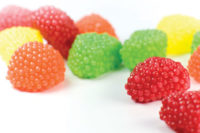 There’s a lot of sweetening going on; and it’s involving sugar a lot less of the time. As readers have undoubtedly discovered, media buzz regarding sugar hasn’t been positive during the past year.
There’s a lot of sweetening going on; and it’s involving sugar a lot less of the time. As readers have undoubtedly discovered, media buzz regarding sugar hasn’t been positive during the past year.
A recent report by Cleveland-based The Freedonia Group on alternative sweeteners relates, “Sugar, once regarded as a threat mainly to dental health, has acquired a negative health image in general as a result of heightened diabetic awareness, stricter sugar consumption wording in the new Dietary Guidelines for Americans, and the highly popular Atkins Diet and similar programs.”
This demonizing of sugar has prompted a rebuttal by sugar grower groups and associations in response, who have pointed out that sugar, after all, is a natural ingredient.
But as with many food debates, the intensity of the discussion and the size of the headlines doesn’t always translate into mainstream momentum. In this instance, however, there’s certainly been increased public awareness about sugar intake, specifically burrowing down into the kinds of sugars used, be it organic, beet, cane or “corn” sugar.
With regards to the confectionery industry, consumer attitude about sugar consumption hasn’t had as much impact as the actual cost of sugar, thanks to the U.S. government’s existing subsidy sugar program.
Costs, as well as public perception, are fueling growth in sugar-free or reduced-sugar confections.
According to The Freedonia Group report, alternative sweeteners in candy and confections are forecast to rise 3.4% per year to $256 million in 2015.
As the author notes, “Demand will continue to be driven by increasing numbers of consumers who are concerned about their caloric intake and oral health, and want to be free of guilt and health concerns as they satisfy their sweet tooth. Sugarless or reduced sugar candies and confections have come to be perceived by a large portion of consumers as an acceptable alternative to high sugar-content products.”
The report does caution, however, that sugar reduction, in lieu of complete sugar replacement, will limit growth. It also notes that sugar-free chocolate, even reduced sugar chocolate, still remains a small sub-segment of the chocolate category, which constitutes the largest U.S. confectionery segments. However, a growing trend toward sugar reduction (instead of total sugar replacement) will limit any spectacular sugar-free surge.
“Although growth will be above average from a small base, alternative sweeteners have not worked as well in chocolate candy as they have in mints, gum and hard candy,” The Freedonia Group report says.
Having evolved from the dietetic food segment, sugarless candies and confections continue to offer alternatives to consumers who monitor their intake of not only sugar, but fat, carbohydrates and calories.
As The Freedonia Group’s analysis asserts, “Alternative sweeteners have benefited not only from increased consumer interest, but also from the broader assortment of sweeteners available and their ease of use. For example, the good temperature stability of ace-K and sucralose allow their addition to hard candy formulations prior to cooking. Blending of high intensity sweeteners and bulk sweeteners such as polyols has improved functionality while producing better tasting products more reminiscent of traditional products made with sugar or corn syrup.”
The latest evolution in sweeteners comes in the development of natural alternatives, such as erythritol, a sugar alcohol obtained through fermentation, or stevia, a plant that delivers intense sweetness.
Typically, erythritol is not used in hard candy because of its brittleness, its inability to achieve a hard glass state, quick crystallization, grainy texture, and less-than-appealing hard candy appearance.
However, in response to discussions with a customer that manufactures natural products, Cargill developed Zerose erythritol as well as a new hard candy process to go with the ingredient.
Consequently, Zerose erythritol allows for a natural and sugar-free claim in the United States while the new processing method produces candies that are level, smoother and more aesthetically pleasing in appearance with less production waste and faster production times.
Full sugar, hard-boiled candy is comprised of sugar, corn syrup, flavors, colors and acids. It is boiled beyond the boiling stage to evaporate as much water as possible, which gives the candy its glassy state.
With Cargill’s solution, there is no water to evaporate. The key step is melting the ingredients until they are liquefied in order to pour the “melt” into moulds. As a result, Cargill’s new erythritol-based hard candy formula provides cost savings as there is no need to individually wrap pieces, like other hard candies, and the cooking time is decreased because of the omission of the hard-boiled stage.
Lately, stevia has been gaining acceptance as a natural sweetener alternative to sugar. In 2008 rebaudioside A, an extract derived from stevia, was approved as a food supplement in the United States. Just last December, the European Community approved stevia’s use in food products.
Ragold’s Sweet recently re-launched its Velamints product touting the use of Truvia, Cargill’s stevia product. While confectionery applications involving stevia can be straightforward in the production of mints, hard candy processes require a bit more attention, such as adding stevia later in the cooking process.
Still, prospects look attractive for sweeteners that can allow confectioners to claim all-natural goodness and sweetness simultaneously. With apologies to Mary Poppins, “A spoonful of goodness does help the sweetener go down.”





